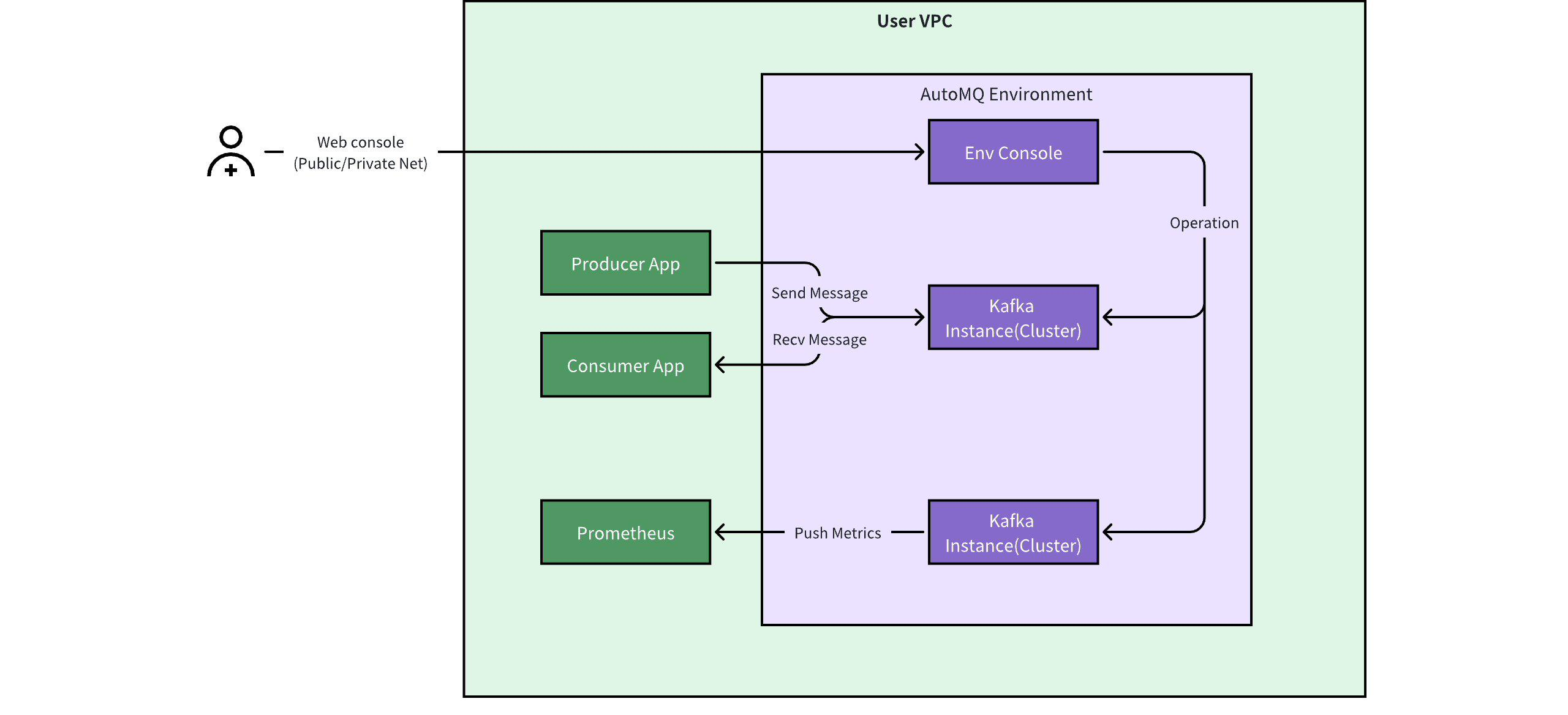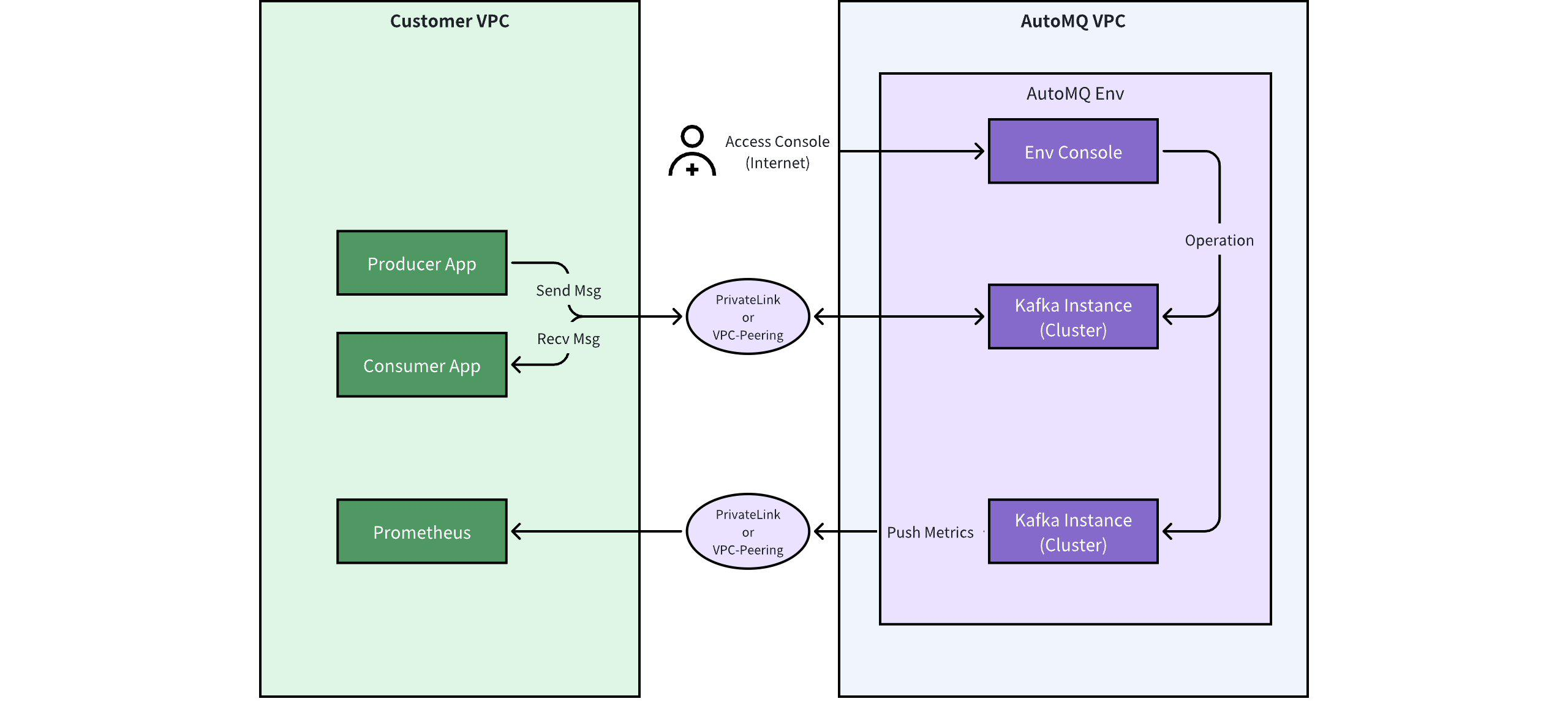Overview
This article explains the definition, resource model, internal characteristics, classification, and usage recommendations of the AutoMQ Cloud environment, an essential operational resource within AutoMQ Cloud.
When this document mentions the service provider, service side, or AutoMQ itself, it is specifically referring to AutoMQ CO.
The terms "cloud providers" and "public cloud providers" in this article are used to describe the underlying cloud services that support AutoMQ Cloud, including AWS, Google Cloud, Azure, Alibaba Cloud, Tencent Cloud, Huawei Cloud, and others.
Definition
Within AutoMQ Cloud, an environment is a logical abstraction of resources that determines the basic configuration shared at runtime for Kafka, and manages the actual Kafka instances (clusters). This environment sets parameters such as the type of infrastructure, network setting, and permission policies, under which all subsequent Kafka instances are created and managed.
The primary functions of an environment are outlined as follows:
It dictates the underlying infrastructure for Kafka services, detailing the type of cloud provider, region, and fundamental permission policies.
It defines the underlying network topology, availability zone configuration, and how the entire control system's external services are exposed.
Agree on standardized foundational configurations across instances, such as Metrics integration settings.
Environments are categorized into SaaS and BYOC based on the ownership of the underlying resources and operational responsibilities. In a SaaS environment, AutoMQ CO. owns all the physical resources and handles maintenance and management; in a BYOC environment, the user owns all physical resources while AutoMQ CO. is authorized to handle maintenance and management.
Model Relationships
In the domain model of AutoMQ Cloud, the environment serves as the top-level resource for managing product instances, as depicted below:

Internal Attributes
Attribute: Infrastructure Configuration
Infrastructure Configuration is a critical setting required for deploying environments in AutoMQ Cloud, aimed at establishing the type of infrastructure, network topology, and policy settings. The environment console will leverage this configuration to deploy and manage actual Kafka clusters.
Attribute: Integration Configuration
Integration configuration serves as a uniform abstraction for settings that are common across clusters and is utilized for external data integration at the environment level. For example, Metrics integration configuration allows for the aggregation of Metrics data from various clusters within the environment to a designated Prometheus cluster, enabling tailored monitoring and analysis.
Attribute: Environment Version
Technologically, the environment acts as a foundational software layer. Consequently, it undergoes continual software updates, resulting in multiple versions of the environment. Updating environment versions typically does not impact the services on higher layers. Users are encouraged to frequently upgrade to the most recent environment version to benefit from bug fixes and feature improvements.
Attribute: Environment Status
The environment status indicates the operational states throughout the lifecycle of the environment, encompassing the following stages and statuses:

Creating: The initial setup of the environment is an asynchronous operation. Once complete, the backend asynchronously deploys the entire software base. During this phase, users are unable to make any modifications until the setup is complete.
Running: The current environment is in a stable operational state, permitting routine maintenance activities such as adding, deleting, modifying, and querying of internal product instances.
Changing: The environment is currently undergoing maintenance modifications or version updates. Since these processes are asynchronous, completion must be awaited, and modifications to the environment are restricted during this time.
Service Outage: The service is currently unavailable due to activities such as creation, maintenance adjustments, or anomalies in the underlying infrastructure.
BYOC Environment
Environmental Architecture
As previously discussed, the BYOC environment is managed by AutoMQ Cloud, with underlying resources allocated to a VPC within the user's custom cloud account. This configuration ensures full data isolation and independent control. The arrangement of the data plane and control plane systems in this environment is outlined below:

Resource Location: Both the control plane system (environment console) and data plane system (Kafka service cluster) are situated within the user-defined network environment.
Network Exposure: By default, the environment console is accessible via the public network based on user preferences, although access can be restricted to only the private network. Currently, the data plane system permits only private network access.
Operational Authorization: The BYOC environment operates in a completely private, network-isolated setting, requiring user authorization to allow AutoMQ to manage the environment on the user's behalf (for troubleshooting and version upgrades).
PublicCloud Environment
Environmental Architecture
As noted earlier, the PublicCloud environment is managed and maintained by AutoMQ Cloud. This type of environment includes both a data plane system and a control plane system, as illustrated in the figure below:
